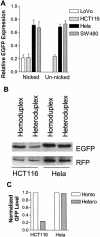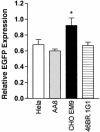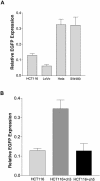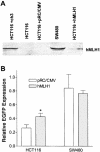Measurement of DNA mismatch repair activity in live cells
- PMID: 15249596
- PMCID: PMC484197
- DOI: 10.1093/nar/gnh098
Measurement of DNA mismatch repair activity in live cells
Abstract
Loss of DNA mismatch repair (MMR) function leads to the development and progression of certain cancers. Currently, assays for DNA MMR activity involve the use of cell extracts and are technically challenging and costly. Here, we report a rapid, less labor-intensive method that can quantitatively measure MMR activity in live cells. A G-G or T-G mismatch was introduced into the ATG start codon of the enhanced green fluorescent protein (EGFP) gene. Repair of the G-G or T-G mismatch to G-C or T-A, respectively, in the heteroduplex plasmid generates a functional EGFP gene expression. The heteroduplex plasmid and a similarly constructed homoduplex plasmid were transfected in parallel into the same cell line and the number of green cells counted by flow cytometry. Relative EGFP expression was calculated as the total fluorescence intensity of cells transfected with the heteroduplex construct divided by that of cells transfected with the homoduplex construct. We have tested several cell lines from both MMR-deficient and MMR-proficient groups using this method, including a colon carcinoma cell line HCT116 with defective hMLH1 gene and a derivative complemented by transient transfection with hMLH1 cDNA. Results show that MMR-proficient cells have significantly higher EGFP expression than MMR-deficient cells, and that transient expression of hMLH1 alone can elevate MMR activity in HCT116 cells. This method is potentially useful in comparing and monitoring MMR activity in live cells under various growth conditions.
Figures







Similar articles
-
DNA mismatch repair (MMR) mediates 6-thioguanine genotoxicity by introducing single-strand breaks to signal a G2-M arrest in MMR-proficient RKO cells.Clin Cancer Res. 2003 Jun;9(6):2327-34. Clin Cancer Res. 2003. PMID: 12796402
-
Effect of H(2)O(2) on cell cycle and survival in DNA mismatch repair-deficient and -proficient cell lines.Cancer Lett. 2003 Jun 10;195(2):243-51. doi: 10.1016/s0304-3835(03)00145-9. Cancer Lett. 2003. PMID: 12767533
-
In vivo DNA mismatch repair measurement in zebrafish embryos and its use in screening of environmental carcinogens.J Hazard Mater. 2016 Jan 25;302:296-303. doi: 10.1016/j.jhazmat.2015.09.056. Epub 2015 Sep 30. J Hazard Mater. 2016. PMID: 26476317
-
DNA mismatch repair deficiency, resistance to cancer chemotherapy and the development of hypersensitive agents.Curr Top Med Chem. 2005;5(12):1133-49. doi: 10.2174/156802605774370883. Curr Top Med Chem. 2005. PMID: 16248788 Review.
-
Complementation of mismatch repair gene defects by chromosome transfer.Mutat Res. 1998 Jun 18;402(1-2):15-22. doi: 10.1016/s0027-5107(97)00277-7. Mutat Res. 1998. PMID: 9675233 Review.
Cited by
-
Gene silencing induced by oxidative DNA base damage: association with local decrease of histone H4 acetylation in the promoter region.Nucleic Acids Res. 2010 Jul;38(13):4285-95. doi: 10.1093/nar/gkq170. Epub 2010 Mar 24. Nucleic Acids Res. 2010. PMID: 20338881 Free PMC article.
-
Inter-individual variation in DNA repair capacity: a need for multi-pathway functional assays to promote translational DNA repair research.DNA Repair (Amst). 2014 Jul;19:199-213. doi: 10.1016/j.dnarep.2014.03.009. Epub 2014 Apr 26. DNA Repair (Amst). 2014. PMID: 24780560 Free PMC article.
-
Large-scale preparation of fluorescence multiplex host cell reactivation (FM-HCR) reporters.Nat Protoc. 2021 Sep;16(9):4265-4298. doi: 10.1038/s41596-021-00577-3. Epub 2021 Aug 6. Nat Protoc. 2021. PMID: 34363069 Free PMC article.
-
DNA mismatch repair is required for the host innate response and controls cellular fate after influenza virus infection.Nat Microbiol. 2019 Nov;4(11):1964-1977. doi: 10.1038/s41564-019-0509-3. Epub 2019 Jul 29. Nat Microbiol. 2019. PMID: 31358986 Free PMC article.
-
Rad9 plays an important role in DNA mismatch repair through physical interaction with MLH1.Nucleic Acids Res. 2008 Nov;36(20):6406-17. doi: 10.1093/nar/gkn686. Epub 2008 Oct 8. Nucleic Acids Res. 2008. PMID: 18842633 Free PMC article.
References
-
- Modrich P. and Lahue,R. (1996) Mismatch repair in replication fidelity, genetic recombination, and cancer biology. Annu. Rev. Biochem., 65, 101–133. - PubMed
-
- Fishel R. (1998) Mismatch repair, molecular switches, and signal transduction. Genes Dev., 12, 2096–2101. - PubMed
-
- Umar A. and Kunkel,T.A. (1996) DNA-replication fidelity, mismatch repair and genome instability in cancer cells. Eur. J. Biochem., 238, 297–307. - PubMed
-
- Kolodner R.D. and Marsischky,G.T. (1999) Eukaryotic DNA mismatch repair. Curr. Opin. Genet. Dev., 9, 89–96. - PubMed
-
- Modrich P. (1997) Strand-specific mismatch repair in mammalian cells. J. Biol. Chem., 272, 24727–24730. - PubMed
Publication types
MeSH terms
Substances
Grants and funding
LinkOut - more resources
Full Text Sources
Miscellaneous

